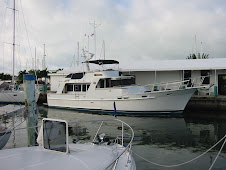Wednesday, July 25, 2012
July 13 - 15, 2012 - Into Lake Superior
This morning we departed Sault Ste. Marie as the bow of the Laker Algoma Mariner loomed large through our salon doorway. She was headed for the MacArthur Lock.
We entered the Canadian Canal Recreational Lock. This was our first transit of this lock, as last time we passed through, it was closed for repairs and we used the much larger commercial MacArthur Lock. In the distance is the International Bridge, celebrating its 50th birthday. There is lots to celebrate locally, as this year is the 100th birthday of Sault Ste. Marie, Ontario, and the 200th anniversary of the War of 1812, which saw some action nearby.
One of the most elegant lockkeepers cottages we have ever seen is right next to this lock.
Now we are in Lake Superior, so named by early explorers not because it is the largest (though it is, with a surface area of more than 31,000 square miles) in the world, nor the best (though some would argue it is) of the Great Lakes, but because it is most northerly, and at the highest elevation above sea level. We took the northern route along the Ontario shoreline, where hundreds of wind turbines provide green power for the local utility, taking advantage of the reliable westerlies.
Our night’s anchorage is in beautiful Batchawana Bay, near a provincial park of the same name. Trans-Canadian Highway 17 runs along the eastern shore here. But we couldn’t hear if from the Harmony Bay part of Batchawana Bay, a beautiful, large, protected and secluded place to set our hook. The water was an unexpected 75 degrees warm; soon, we took a refreshing swim.
The next night’s anchorage in Sinclair Cove came highly recommended, not only for its protected basin, but also for fascinating ancient rock paintings just around the corner at Agawa Rock.
Just ¼ mile from Monarch, toward the Agawa Islands are these Ojibwa pictographs, at the water’s edge beneath thirty-meter high overhanging cliffs. Visitors are able to hike here, but we took the dinghy in for a better look.
The red ochre (made from hematite and grease) paintings tell a story of a four-day canoe trip led by great Chief Myeegun from the Carp River in the Porcupine Mountains to Agawa Rock – a distance of 215 nautical miles across Lake Superior.
If you look closely, you can make out canoes, horses and maybe a caribou, or a horned and spiny reindeer. The images are about four feet tall, and date to the 1600s. They are fading as the years go by, so we were glad to see them.
We enjoyed our night on the hook here, and in the morning departed for Michipicoten Island, Lake Superior’s second largest island. The island is 40 miles from the north shore of Lake Superior, isolated and pristine. Early natives were superstitious of the island, due to its undulating appearance, sometimes disappearing in the fog. And today it did!
Along Michipicoten’s south shore we find the entrance to its most secure anchorage, Quebec Harbor, at Davieaux Island Light that is barely visible through the fog. Now automated, this light had a keeper, Gordon Dawson, who manned this remote light for 22 seasons.
Early explorers and natives valued copper deposits on the island, but these were not substantial enough to prove commercially viable. After copper, the fishing industry drew settlers to the shore, with a succession of three fish companies manning a station in Quebec Harbor. We can see the remnants of the station through a band of fog. Today, fishing tugs visit the harbor from the mainland’s Mamainse Harbor, and we see a blue and white turtleback at the dock. The buildings are in disrepair, though there are a few summer camps on the west end of the harbor.
We took up binoculars for a wildlife watch from the aft deck, and were not disappointed. We saw bald eagles, loons, black ducks, goshawks and a beaver. Over the course of the afternoon, we spotted the real highlight – more than a dozen caribou. These were introduced to the island in the 1970s, and are about the size of a small horse, with coats a mottled gray, the bucks with impressive velvet-coated antlers. A cow with a fawn-colored calf loped along the shoreline.
The peaceful setting was the perfect place for our night’s anchorage.
Subscribe to:
Post Comments (Atom)















No comments:
Post a Comment